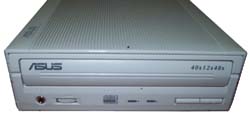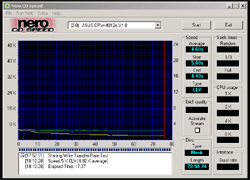ASUS CRW-4012A-U: High Speed Mobile Burning
by Kristopher Kubicki on November 6, 2002 5:03 AM EST- Posted in
- Storage
USB 2.0
For those of you not familiar, USB 2.0 we have a small rundown of the technology to talk about. The USB 2.0 standard, which was finalized in 2000, has finally become more or less a standard on most new motherboards today. The largest advantage in the new standard is the increase in bandwidth over the bus itself.
The USB 1.1 standard is the older and more widely adopted of the two buses. Virtually all new motherboards have at least a USB 1.1 offering for mice, keyboards, digital cameras, etc. Sometimes, this is referred to as “basic speed USB.” USB 1.1 operates at one of two bitrates, 1.5Mbps or 12Mbps. USB 2.0 on the other hand was designed to be an upgrade though not a replacement for USB 1.1. USB 2.0 runs at one of three speeds, 1.5Mbps, 12Mbps or 480Mbps. Obviously, the improvement in bandwidth is dramatic.
USB 1.1 – Theoretical maximum 1,500KBytes/sec
USB 2.0 – Theoretical maximum 60,000KBytes/sec
USB 2.0 is backwards compatible with USB 1.1 devices. As intended by the USB Promoter Group, 1.1 devices and 2.0 devices will still be made. Do not expect to see any mice capable of 480Mbps streams anytime soon, but do expect to plug your USB 1.1 mice into 2.0 nodes.
To get a visual picture of the dramatic difference in bandwidth, we plugged our 4012A-U into a USB 1.1 board and recorded the benchmark with Nero CDSpeed. As you can see, over the USB 1.1 bus the drive never wrote to the disk over 5x.
USB 2.0 compatibility is critical for this drive. For the 129USD price tag, a 5x burner is not acceptable. If your laptop or PC does not support USB 2.0, expect to pay a little bit more with this drive. Since there is no included controller, expect to pay around 30USD for a PCI adaptor or 50USD for a PCMCIA adaptor.












1 Comments
View All Comments
mkagarwal896 - Wednesday, August 30, 2017 - link
From this classical High Speed Mobile Burning from Latest Gaming Laptop, ASUS has improved a lot. http://promocodeclub.com/coolwinks-offers-coupons/